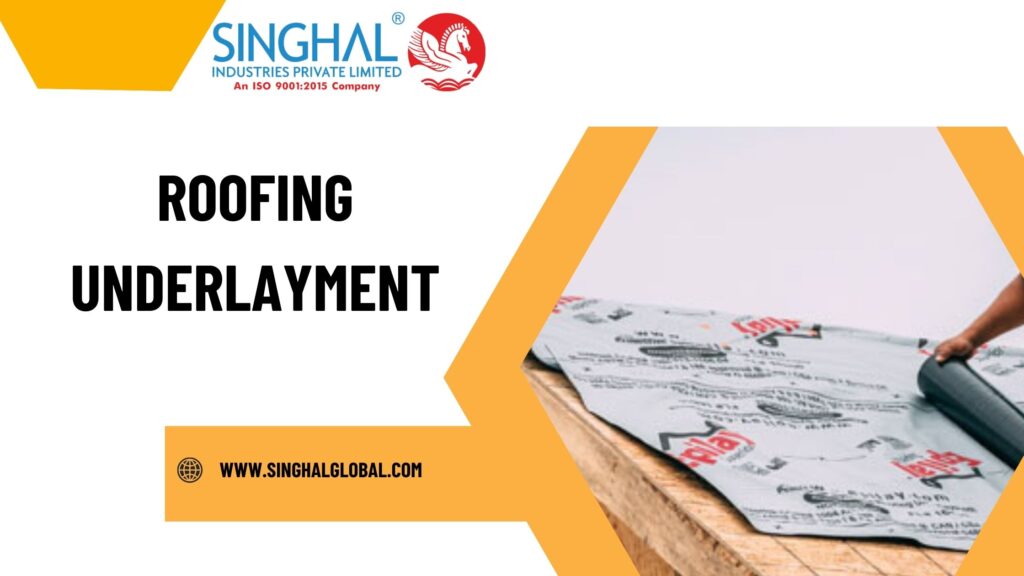
When it comes to roofing, most homeowners focus on the shingles or metal panels that adorn their rooftops. However, an equally important component of a roofing system is often overlooked: roofing underlayment. This critical layer serves as a protective barrier, contributing to the overall durability and longevity of your roof. In this article, we will explore what roofing underlayment is, its benefits, types available, and its role in enhancing the performance of roofs, particularly metal roofs. Additionally, we’ll touch on the best roofing underlayment options and sources for roof underlayments in India, including Pulkit Plastic Products.
What is Roofing Underlayment?
Roofing underlayment is a material that is installed directly onto the roof deck, beneath the primary roofing material (shingles, metal panels, etc.). It acts as a secondary layer of protection, providing a barrier against water infiltration, moisture, and other elements that can compromise the integrity of your roof.
Types of Roofing Underlayment
There are several types of Roof Underlayment For Metal Roofs each designed for specific applications and roofing materials. The most common types include:
- Felt Underlayment
- Composition: Made from paper saturated with asphalt, felt underlayment is a traditional option that has been used for decades.
- Advantages: It is relatively inexpensive and easy to install. Available in various thicknesses (typically 15 or 30 pounds), it provides decent protection against moisture.
- Use: Commonly used with asphalt shingles.
- Synthetic Underlayment
- Composition: Made from polypropylene or polyethylene, synthetic underlayment is a newer option that offers superior durability.
- Advantages: It is lighter, more tear-resistant, and often comes with a slip-resistant surface. It also provides excellent water resistance.
- Use: Suitable for all types of roofing, including metal roofs, making it a versatile choice.
- Rubberized Underlayment
- Composition: This type consists of a rubberized asphalt material, providing excellent waterproofing properties.
- Advantages: It is ideal for areas prone to ice dams or heavy rainfall, offering superior water protection.
- Use: Frequently used in climates with harsh weather conditions or for roofs with a steep slope.
Benefits of Roofing Underlayment
Investing in roofing underlayment comes with several key benefits:
1. Water Protection
Roof underlayment acts as a barrier against moisture. In the event of a leak in the primary roofing material, the underlayment provides an additional layer of defense, preventing water from seeping into the roof deck and causing structural damage.
2. Enhanced Durability
Underlayment adds to the overall durability of the roof by protecting the roof deck from harsh weather conditions, including rain, snow, and UV rays. This can significantly extend the life of your roofing system.
3. Improved Energy Efficiency
Some types of roofing underlayment have reflective properties that can help keep your home cooler in hot weather. This can reduce energy costs associated with cooling, making your home more energy-efficient.
4. Noise Reduction
For metal roofs, roofing underlayment can help dampen noise from rain or hail, creating a quieter indoor environment.
5. Ease of Installation
Most roofing underlayments are lightweight and easy to handle, which can speed up the installation process. This efficiency can save time and labor costs for roofing contractors.
Roofing Underlayment for Metal Roofs
Metal roofs are increasingly popular due to their durability and longevity. However, they also require specific considerations regarding underlayment:
- Moisture Control: Metal roofs can be prone to condensation, especially in humid climates. Using a quality underlayment helps mitigate moisture issues and protect the underlying structure.
- Thermal Expansion: Metal expands and contracts with temperature fluctuations. A flexible underlayment can accommodate this movement without compromising the roof’s integrity.
- Best Practices: For metal roofs, it’s crucial to use a high-quality synthetic or rubberized underlayment designed specifically for metal applications, ensuring maximum protection.
Choosing the Best Roofing Underlayment
When selecting the Best Roofing Underlayment for your project, consider the following factors:
- Climate Conditions: Choose a material that can withstand the specific weather conditions in your area. For instance, in regions with heavy rainfall, opt for a rubberized or synthetic underlayment.
- Roof Type: Ensure the underlayment is compatible with your roofing material. For metal roofs, synthetic options are often preferred for their durability.
- Budget: While high-quality underlayment may have a higher upfront cost, it can save you money in the long run by enhancing roof durability and reducing maintenance needs.
- Manufacturer Reputation: Look for reliable suppliers or manufacturers known for quality roofing products. In India, Pulkit Plastic Products is a reputable source for various roofing materials, including underlayments.
Roof Underlayments in India
The demand for high-quality Roof Underlayments in india due to the country’s diverse climate and increasing construction activities. Various manufacturers offer different types of roofing underlayment tailored to local needs.
Factors to Consider When Sourcing in India:
- Quality Standards: Ensure that the products meet local and international quality standards for durability and performance.
- Availability: Look for suppliers who can provide consistent availability of products to avoid delays in your project.
- Customer Support: Choose manufacturers that offer excellent customer support and guidance for product selection and installation.
Pulkit Plastic Products stands out in this market by offering a variety of roofing underlayment options suitable for different applications and climate conditions in India.
Conclusion
Roofing underlayment is a critical component of a comprehensive roofing system, providing an essential layer of protection against moisture and other environmental factors. By understanding the various types of underlayment available, their benefits, and how they apply specifically to roofing materials like metal, homeowners and contractors can make informed decisions that enhance the durability and efficiency of their roofs. For those in India, sourcing high-quality roof underlayments from reputable manufacturers like Pulkit Plastic Products can ensure optimal performance and protection for years to come. Investing in the right roofing underlayment is not just about following best practices; it’s about safeguarding your home and ensuring its longevity.
Frequently Asked Questions (FAQ)
What is roofing underlayment?
Roofing underlayment is a protective layer installed under the primary roofing material to prevent water infiltration and protect the roof deck.
Why is roofing underlayment important?
It provides an additional layer of protection against moisture, enhances the durability of the roof, improves energy efficiency, and reduces noise.
What types of roofing underlayment are available?
The most common types include felt underlayment, synthetic underlayment, and rubberized underlayment. Each has its advantages depending on the roofing material and climate.
Can roofing underlayment be used for metal roofs?
Yes, roofing underlayment is essential for metal roofs to control moisture and accommodate thermal expansion. Synthetic and rubberized underlayments are often the best choices.
Where can I find roof underlayments in India?
Roof underlayments can be sourced from various manufacturers in India, including Pulkit Plastic Products, which offers a range of high-quality roofing materials.




